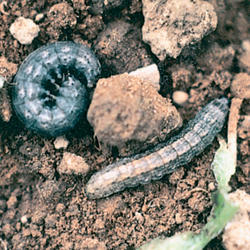Greasy cutworm (Agrotis Ipsilon)
Greasy cutworm are found throughout New Zealand and can be a serious problem in seedling maize crops. Greasy cutworm has a wide host range including maize, sweet corn, cereals, grasses, lucerne, white clover, plantain, vegetables and weeds such as docks.
Life cycle
The Greasy cutworm moth can be present all year round, however they are most commonly found from October to April. Each female moth lays around 600-800 eggs. After hatching young larvae forage on leaves until they are about 30% fully grown in size. Larger larvae live about 2.5-5cm below the soil surface during the day, emerging at night to feed. When fully developed, larvae form earthen cells in the top 5cm of soil where they pupate. The summer cycle usually takes about 7-12 weeks, depending on climate. Greasy cutworm over-winter as larvae and pupae. There are two to three generations per year.
Identification
Moths are a dark mottled brown to grey/brown in colour and are about 3.5-5cm in length. Smaller larvae are red/brown to grey/brown, while larger larvae are grey/green in colour with two yellow stripes down the body, growing up to 5cm in length.The pupae are 1.5-2.5.cm in length and are red/brown in colour, turning black just before the moth emerges.
Feeding
The larger larvae cause the most damage to young maize plants, cutting seedlings off at their base or tunneling into stems. Plants cut above the growing point usually survive, but have greatly reduced yield. Populations of three larvae per 100 plants before the two leaf stage or six larvae per 100 plants at the two-four leaf stage can reduce plant numbers by over 10,000/ha.
Protection and control
- Poncho maize seed treatment for protection during plant establishment.
- Contact insecticide pre-sowing to reduce adult population, especially out of old pasture.
- Thorough cultivation and good weed control to eliminate host plants such as docks and wild plantain.
For more information visit the Ag Pest website.




